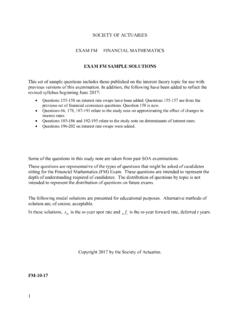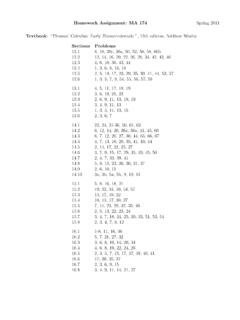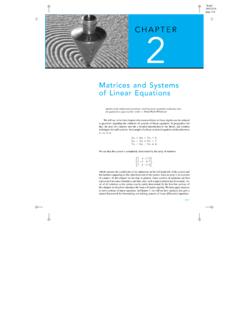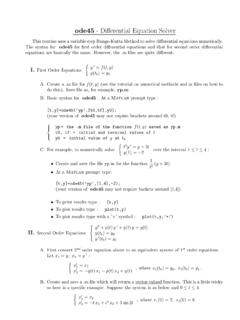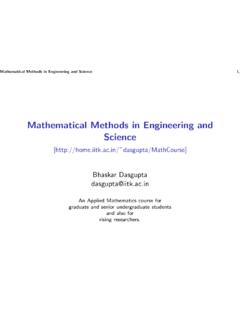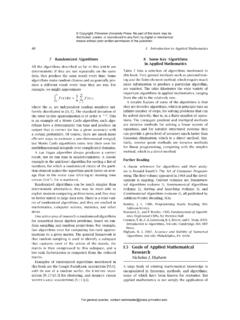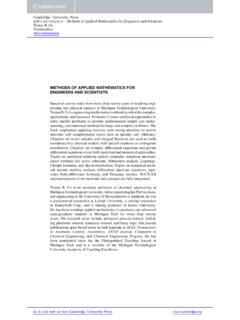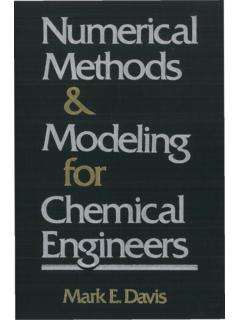Transcription of MA 611 Methods of Applied Mathematics: Final
1 MA 611 Methods of AppliedMathematics: FinalYingwei Wang Department of mathematics , Purdue University, West Lafayette, IN, USA1 Ordinary differential equationFact:u + u= 0,( )w(0) =w( ) = 0,( )has nontrivial solutions if and only if n=n2,( )un=Asin(nx),( )wheren= 1,2, andAis a the problem: w +w=f,( )w(0) =w( ) = 0.( )LetT B(L2(0, ), L2(0, )) be given byT(f) =w. This is the Final project of Prof Phillips s lecture (Spring 2011).1 Yingwei WangMethods of Applied SpectrumQuestion:Give the spectral representation :In class, we have known thatTis compact andT=T .Consider the eigenvalue problem( I T)u= 0, u=T u,where 6= u= uinto Eq.
2 ( ), we can get u + u=u, u +1 u= ( ) and ( ), we know that1 n n=n, n=1n2+ 1,( )un= sin(nx).( )Then the spectral representation ofTisT f= n=1 n(f,sin(nx)) sin(nx),( )where (f,sin(nx)) = 0fsin(nx) Solve ODEsQuestion:Find the general solution to each of the following problems. If the solutiondoes not exit explain why. w +aw=bx+c,( )w(0) =w( ) = 0.( )2 Yingwei WangMethods of Applied MathematicsSolution:Consider the problem w +w w=f,( )w(0) =w( ) = 0,( )which implies thatw=T( w+f) = T w+T f, w T w=T f, n=1 n=n2+ 1.( )If 6= n, then the general solution isw= n=1(f,sin(nx)) n sin(nx).
3 ( )If = N, then the general solution isw= n=1,n6=N(f,sin(nx)) n sin(nx) +Asin(Nx),( )whereAis a 1, b= 2, c= In this case, = 26= nandf= 2x .(f,sin(nx)) = 0(2x ) sin(nx)dx= 02xsin(nx)dx 0 sin(nx)dx= 2 n( 1)n [1 ( 1)n] n= n[( 1)n+1 1]It is obviously that ifn= 1, then (f,sin(nx)) = WangMethods of Applied MathematicsBy Eq.( ), the general solution of this problem isu= n=2 [( 1)n+1 1]n(n2 1)sin(nx).( )It is easy to verify that the series ( ) is 3, b= 0, c= In this case, = 46= nandf= .(f,sin(nx)) = 0 sin(nx)dx= [1 ( 1)n] Eq.( ), the general solution of this problem isu= n=1 [1 ( 1)n]n(n2 3)sin(nx).
4 ( )It is easy to verify that the series ( ) is 4, b= 1, c= In this case, = 5 = 2andf=x+ .(f,sin(nx)) = 0(x+ ) sin(nx)dx= Eq.( ), the general solution of this problem isu= n=1,n6=2 n(n2 4)sin(nx) +Asin(2x).( )2 IsometryLet{en, n= 1,2, }be the orthogonal Hilbert basis generated byTfrom Section :(i) The map :f L2(0, ) ((f, e1),(f, e2), ,) l2is an isometry.(ii)H10(o, ) is the closure of the set{u C1[0, ] :u(0) =u( ) = 0}in the normkukH10=( (u2+u 2)dx)1 WangMethods of Applied Norm-preservingQuestion:SetG={a l2:kakG= ( n=1(1 +n2)a2n)1/2< }. Recall that thel2norm iskakl2= ( n=1a2n)1 that :H10(0, ) (G,k kG) is an :Chooseen= 2 sin(nx), then it is easy to verify that n N+,(en, em) =2 0sin(nx) sin(mx)dx= mn,( )(e n, e m) =2 nm 0cos(nx) cos(mx)dx=n2 mn.
5 ( )For f H10(0, ), we havef= n=1(f, en)en,( )f = n=1(f, en)e n.( )Now we know that (f) = ((f, e1),(f, e2), ,) G, f H10(0, ).It is obvious that is a one-to-one linear map fromH10(0, ) ontoG. We need toshow that is 0f2+ (f )2dx= 0( n=1(f, en)en)2+( n=1(f, en)e n)2dx= n=1(f, en)2+n2(f, en)2=k (f) WangMethods of Applied Compact imbeddingQuestion:To proveI:H10(0, ) L2(0, ) is compact by showingI: (G,k kG) l2is :Define the operatorTn=G l2byTn(a) = (a1, , an,0, ) l2, a= (a1, a2, ) any bounded subsetX G,Tn(X) is finite dimension and bounded, soTn(X)is sequentially compact.
6 It implies thatTnis compact for ,limn Tn(a) =I(a), a : (G,k kG) l2is identity we havelimn kTn(a) I(a)kl2= limn k(0, ,0, an+1, )kl2= 0, a G, limn kTn Ik= sup limn kTn(a) I(a)kl2kakG= 0,which implies that{Tn}is uniformly convergent toI. By Theorem in Friedman sbook,I: (G,k kG) l2is a compact (0, ) (G,k kGandL2(0, ) l2, where means isometry, we knowthatI:H10(0, ) L2(0, ) is also a compact Adjoint operatorQuestion:LetHbe a Hilbert space. Assume thatSandTare linear maps fromHtoHsuch that(Sx, y) = (x, T y), x, y H.( )Prove thatS B(H, H) andT=S .Solution:First, we claim thatkTk= WangMethods of Applied MathematicsOn one hand, choosingy=Sxin ( ) andx6= 0, we can getkSxk2= (Sx, Sx) = (x, T Sx) kxkkTkkSxk, kSxkkxk kTk, x H, kSk kTk.)
7 ( )On the other hand, choosingx=T yin ( ) andy6= 0, we can getkT yk2= (T y, T y) = (ST y, y) kSkkT ykkyk, kT ykkyk kSk, y H, kTk kSk.( )( ) and ( ) imply thatkTk= , we claim thatSshould be fixedy6= 0, consider this operator:Sy:x (Sx, y).On one hand,Syis a linear functional onH. By Riesz s terrorem,ycan be viewedas a bounded linear functional. SoSy=y the other hand, by Eq.( ),Sycan also be viewed as the inner productSy(x) =(x, T y) andkSyk=kT ifSis unbounded, thenSy=y Sis also unbounded, thenkTyk= , y6=0 H, which is a contradiction with the fact thatTis a linear map , by the definition of adjoint operator,T=S.
8 4 Self-adjoint operatorQuestion:LetHbe a Hilbert space. IfA B(H, H) and (Ax, x) Rfor allx Hprove thatA=A .Solution:Letx, y Hand C. By assumption, we know that(A(x+ y), x+ y) R, (A(x+ y), x+ y) = (x+ y, A(x+ y)), (Ax, x) + (Ax, y) + (Ay, x) +| |2(Ay, y) = (x, Ax) + (x, Ay) + (y, Ax) +| |2(y, Ay), (Ax, y) + (Ay, x) = (x, Ay) + (y, Ax),( )7 Yingwei WangMethods of Applied Mathematicswhich is true for = 1, iin ( ) respectively, we can get(Ax, y) + (Ay, x) = (x, Ay) + (y, Ax),( ) (Ax, y) + (Ay, x) = (x, Ay) + (y, Ax).( )From Eqs.( )-( ), we can get(Ay, x) = (y, Ax),(Ax, y) = (x, Ay),which shows thatA=A.
9 5 Hilbert spaceLetHbe an infinite-dimensional, separable Hilbert space and let{en}be an :LetYbe a normed linear space. IfT:H Yis a linear compact operator,please prove thatlimn T(en) = 0.( )Solution:Since any infinite-dimensional separable Hilbert space is isometricallyisomorphic tol2(corollary in Friedman s book), here we can assume thatH= (0, ,0,1,0 )twhere 1 is located in thenth , sinceH =l2, and for fixedj,limn (ej, en) = 0,we can get that for anyf H ,limn f(en) = implies thatenis weakly convergent to Theorem in Friedman s book, sinceTis compact, thenT(en) is (strongly)convergent toT(0) = 0, which implies ( ).
10 8 Yingwei WangMethods of Applied :LetYbe a Banach space andT B(H, Y). Prove that if n=1kT(en)k2< ,( )thenTis :Without loss of generality, we assume thatH=l2. Then for x=(x1, x2, ) H,T(x) = k=1xkT(ek).Define the operatorTn:H YbyTn(x) =n k=1xkT(ek).Then we havelimn Tn(x) =T(x), x any bounded subsetX H,Tn(X) is finite dimension and bounded, soTn(X)is sequentially compact. It implies thatTnis compact for ,x l2means n=1|xn|2< .( )By ( ) and ( ), we can getlimn kTn(x) T(x)k limn k=n+1|xk|kT(ek)k= 0, x H, limn kTn Tk= sup limn kTn(x) T(x)kkxk= 0,which implies that{Tn}is uniformly convergent toT.


